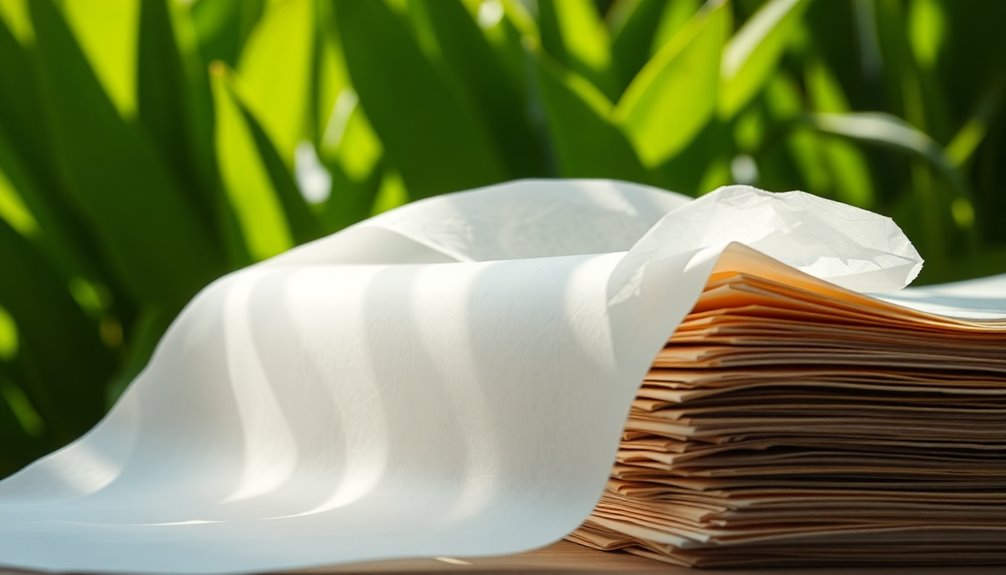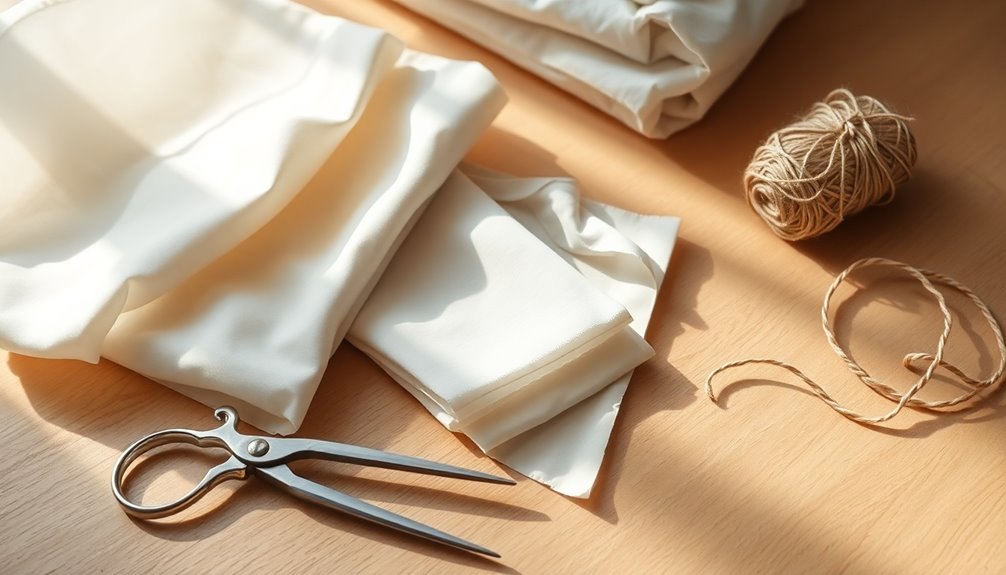Tissue paper differs from other types of paper mainly in its thinness, softness, and absorbency. It typically weighs between 10-35 grams per square meter, making it much lighter than standard paper like printer paper. Made from wood pulp and sometimes recycled materials, tissue paper is designed for delicate uses, from facial tissues to napkins and paper towels. The unique manufacturing process, including creping and chemical additives, enhances its texture and water absorption. If you're curious about its various applications and the environmental impact, you'll find more intriguing details ahead.
Key Takeaways
- Tissue paper is lighter, typically weighing between 10-35 gsm, compared to standard printing paper which weighs 60-120 gsm.
- Its high absorbency is enhanced by the creping process, making it ideal for moisture-related applications.
- Tissue paper is softer due to additives and minimal refining, resulting in a gentle texture for personal hygiene use.
- It is primarily made from wood pulp or recycled materials, while other paper types may use different fiber sources and compositions.
- The manufacturing process of tissue paper incorporates specific steps like creping and drying, which differ from the processes used for other paper types.
Composition and Texture

Have you ever wondered what makes tissue paper so different from other types of paper? The primary material in tissue paper is wood pulp, often sourced from softwood trees like pine, which lends it its unique qualities.
You might also find tissue papers made from alternative fibers such as bamboo and sugarcane, catering to sustainable practices. Some even incorporate cotton fibers, enhancing both softness and strength.
The cellulose content plays a crucial role in its texture and absorbency. Tissue paper typically includes a mix of long-fiber cellulose from conifers, which adds strength, and short-fiber cellulose from eucalyptus or acacia, which boosts softness. Additionally, many tissue papers are made with recycled paper, further contributing to their eco-friendly appeal.
You may notice that many tissue papers also utilize recycled materials, reducing environmental impact.
Chemical additives, like softening agents and bleaching agents, help achieve that desired smoothness and absorbency. The process of creping further enhances the softness, creating microscopic spaces among the fibers that allow water to soak in quickly.
Ultimately, this combination of materials and techniques gives tissue paper its distinct composition and texture, setting it apart from other types of paper.
Weight and Thickness

While many people mightn't think about it, the weight and thickness of tissue paper are key factors that distinguish it from other types of paper. Tissue paper usually weighs between 10-35 grams per square meter (gsm), making it significantly lighter than standard printing paper, which ranges from 60-120 gsm.
For example, a very thin tissue paper can be as light as 10 gsm, while some wrapping papers might weigh slightly more, around 17-45 gsm. In contrast, standard copy paper typically weighs about 80-120 gsm, and cardstock begins at around 120 gsm, showcasing a considerable difference in density and thickness. This difference can be attributed to the fact that tissue paper falls under the 10-35 gsm category, which is classified as having a tissue consistency.
The measurement of tissue paper is often in gsm, providing consistency across different types. Higher gsm values indicate thicker and heavier paper, while lower values show thinner and lighter paper.
This lightweight nature makes tissue paper ideal for delicate uses like facial tissues or wrapping fragile items. Thicker varieties, around 20-45 gsm, are suitable for packaging heavier products, offering varying levels of protection and a luxurious feel.
Manufacturing Process

The manufacturing process of tissue paper typically involves several crucial steps that transform raw materials into the soft, absorbent products you use daily.
It all starts with raw materials, primarily virgin pulp from fresh wood fibers or recycled pulp from paper products. Softwoods like pine and spruce are favored for toilet paper, while hardwoods such as birch and eucalyptus are used for facial tissues. The tissue paper industry has experienced significant growth due to rising demand for disposable products.
Next, the pulping stage begins. Here, you mix the raw materials with water and chemicals to create a pulp slurry. This slurry undergoes a refining process to improve fiber bonding, enhancing the tissue's softness and strength.
Once the fibers reach the right consistency, the slurry moves to the forming section.
In the forming section, the pulp is shaped into a sheet using a crescent former. Press rolls then squeeze out excess water, compacting the fibers. Once the sheet is formed, it's passed through heated drying cylinders to eliminate remaining moisture.
During the creping process, a blade scrapes the dried paper, adding softness. Finally, converting operations like cutting and packaging create various tissue products, ready for your everyday needs.
Key Properties

Tissue paper boasts unique key properties that set it apart from other types of paper. Its composition includes a specific blend of wood pulp, water, and chemicals, often incorporating recycled paper pulp, which enhances its fibrous structure. This gives it a lightweight feel, typically weighing between 10 to 35 grams per square meter, making it substantially thinner than standard printing paper.
One of the defining characteristics of tissue paper is its absorbency, influenced by its high porosity and creping process. The cellulose molecules form hydrogen bonds with water, improving its absorbent capacity. Additionally, its softness is enhanced by using specific starch additives and minimizing refining, resulting in a gentle texture that's perfect for various uses.
Brightness, stretch, and comfort are also significant properties, particularly for hygiene products. The appearance of tissue paper can vary, with options like silk and machine-finished types available. Moreover, its lightweight nature allows for easy handling and storage, which is advantageous in many applications.
Wet strength is crucial in applications where moisture retention is essential. Overall, the bulk and caliper of tissue paper are integral in determining its unique properties, making it a specialized choice for many needs.
Applications

From personal hygiene to specialized industrial uses, tissue paper plays an essential role in everyday life. You probably rely on facial tissues for wiping your face or blowing your nose, and you might've swapped out cloth handkerchiefs for more hygienic options.
In the bathroom, toilet paper and bath tissues ensure cleanliness after use. At the dining table, napkin tissues serve as a convenient substitute for traditional cloth napkins.
In your kitchen, paper towels are invaluable for cleaning surfaces and wiping hands, not to mention their ability to absorb spills effortlessly. You might use tissue paper when preparing food, lining baking trays, or wrapping delicate pastries.
Makeup removal is easy with its gentle touch, while steaming baskets benefit from a liner made of tissue. Additionally, tissue paper's environmental benefits make it a preferred choice for many, as it is sourced from sustainably managed forests.
On a larger scale, tissue paper finds its way into specialized applications like surgical wads in medical settings or as stuffing in clothing manufacturing. It's even used in the packing industry for cushioning items.
Whether you're at home or in an industrial environment, tissue paper's versatility makes it an indispensable material in countless applications.
Environmental Considerations

Considering the environmental impact of tissue paper production is crucial, especially given its significant resource consumption and pollution. You may not realize that producing a single roll of toilet paper requires about 140 liters of water. This process also consumes vast amounts of energy, leading to higher greenhouse gas emissions, particularly when using virgin pulp instead of recycled materials.
The use of chemicals like chlorine for bleaching can pollute local waterways, compounding the environmental issues. The industry's reliance on virgin tree pulp contributes to deforestation, with approximately 27,000 trees cut down daily. This reliance not only adds to carbon dioxide emissions but also exacerbates climate change. Additionally, the biodegradability of tissues means that while they can break down in the environment, their single-use nature adds to landfill waste, creating broader environmental challenges.
Fortunately, the industry is making strides. The increased use of recycled paper requires less energy and raw materials, and many companies are adopting sustainable practices to reduce their ecological footprint.
Look for eco-labels like the EU Flower to identify environmentally friendly options. By choosing recycled tissue paper, you can help mitigate the environmental impact and support a more sustainable future.
Frequently Asked Questions
Can Tissue Paper Be Recycled With Regular Paper Products?
You can't recycle tissue paper with regular paper products in most cases.
Since it's often contaminated with food, oils, or chemicals, it spoils the recycling process. The thin fibers and potential non-paper additives make it unsuitable for recycling facilities.
Check your local recycling policies, but generally, composting clean tissue paper is a better option. You should mix it with other compost materials for a balanced compost pile.
Is Tissue Paper Biodegradable?
Yes, tissue paper is biodegradable. When you dispose of it properly, like in a compost pile, it breaks down naturally within two to four weeks.
The raw materials, such as wood fibers, decompose thanks to microbes, light, air, and humidity.
However, be mindful of how you dispose of it; while the paper is biodegradable, plastic packaging can harm the environment if not discarded correctly.
What Are the Differences in Softness Between Tissue Paper Brands?
When you compare tissue paper brands, you'll notice significant differences in softness.
Some brands use a higher ratio of hardwood fibers, making them feel softer against your skin. Others may incorporate chemical treatments that enhance silkiness.
Additionally, manufacturing techniques like layering and creping can affect how soft the tissue feels.
How Does Humidity Affect Tissue Paper's Performance?
Humidity significantly affects your tissue paper's performance. When humidity rises, the paper's strength can drop, making it more prone to tearing.
While high humidity temporarily boosts absorbency, it can lead to over-saturation, compromising its effectiveness. You might notice the softness initially increases, but prolonged exposure can leave it soggy and uncomfortable.
Testing under controlled humidity levels helps manufacturers improve tissue paper's durability and usability, ensuring better quality for your needs.
Can Tissue Paper Be Used for Printing or Writing?
Yes, you can use tissue paper for printing, but it requires some care.
Make sure your printer is compatible, ideally an inkjet, to avoid smudging. Use the right amount of ink—too much can cause bleeding.
Always print on the side facing down to manage absorption. While you can achieve vibrant colors, remember that darker tissue may require special inks for the best results.
Experimenting with samples can help ensure quality.
Conclusion
In summary, tissue paper stands out from other types of paper due to its unique composition, lightweight texture, and specific manufacturing processes. Its softness and absorbency make it ideal for various applications, from hygiene products to packaging. While it's convenient, you should also consider its environmental impact, as many tissue papers aren't recyclable. Ultimately, understanding these differences helps you make informed choices about the products you use in your daily life.










